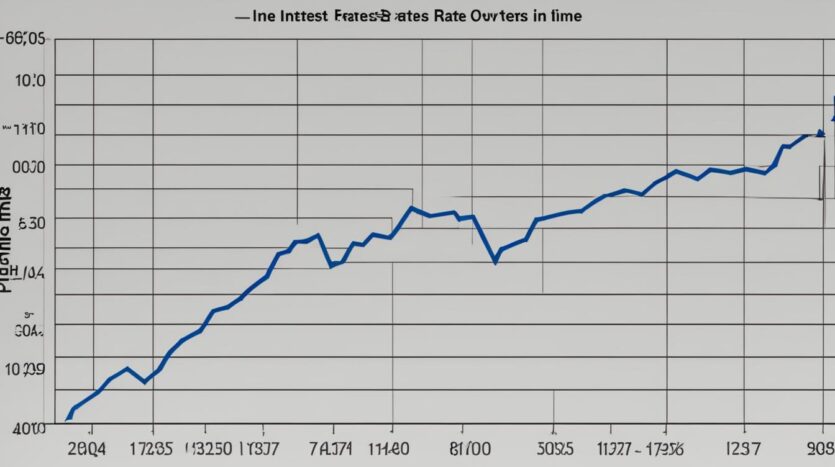Predicting When Will Interest Rates Drop: An Insightful Guide
Are you wondering when interest rates will drop? Understanding and predicting interest rate changes can be a valuable skill, especially if you’re planning to buy a home or refinance your mortgage. In this guide, we will explore the factors that influence interest rate trends and provide insights into future interest rate predictions. Whether you’re a homeowner or a potential homebuyer, this information will help you make informed decisions regarding your finances.
Key Takeaways:
- Interest rate forecasts suggest potential rate cuts in 2024.
- Mortgage rate predictions for 2024 vary, but rates are unlikely to drop below 6%.
- The Federal Reserve’s actions and inflation are key factors in interest rate changes.
- Unemployment rates and treasury yield curves also influence interest rate trends.
- Current mortgage rates have declined from their 2023 peak but remain elevated.
With these insights, you’ll have a better understanding of when interest rates may drop and how they can impact your financial decisions. Let’s dive into the details!
Factors Influencing Interest Rate Trends
Understanding the factors that influence interest rate trends is crucial for predicting when interest rates will drop. Several key elements come into play, including the federal funds rate, inflation, unemployment, and treasury yield curves.
The federal funds rate, controlled by the Federal Reserve, indirectly affects mortgage rates. As the Fed adjusts the federal funds rate in response to inflation and the state of the economy, it can have a ripple effect on other interest rates. Keep an eye on any announcements or changes made by the Federal Reserve as they can provide insights into potential shifts in mortgage rates.
While the federal funds rate is influenced by inflation, it is also directly impacted by the job market. Unemployment rates and jobless claims give us valuable information about the health of the labor market, which in turn affects interest rates. A strong job market may lead to higher interest rates, as it indicates economic growth and increased demand for loans.
Inflation plays a significant role in the Federal Reserve’s decision-making process when it comes to raising or lowering interest rates. If inflation is low, the Fed may be more likely to lower rates in order to stimulate economic growth. Conversely, if inflation is high, the Fed may raise rates to keep inflation in check and maintain economic stability.
Treasury yield curves can also offer valuable insights into interest rate trends. These curves indicate the interest rates on U.S. government bonds of different maturities. When long-term yields are higher than short-term yields, it typically indicates a positive economic outlook, potentially leading to higher mortgage rates. On the other hand, when long-term yields are lower than short-term yields, it suggests a less optimistic economic outlook, which could lead to lower interest rates.
By closely monitoring these factors and their interplay, you can gain a better understanding of the potential direction of interest rates and make more informed decisions regarding your financial plans.

Table: Factors Influencing Interest Rate Trends
| Factor | Influence |
|---|---|
| Federal Funds Rate | Indirectly affects mortgage rates; controlled by the Federal Reserve |
| Inflation | Higher inflation may lead to higher interest rates; lower inflation may lead to lower rates |
| Unemployment | Low unemployment rates and a strong job market may result in higher interest rates |
| Treasury Yield Curves | Indicate economic perception and potential recessions; impact interest rate trends |
Examining these factors and their impact on interest rates allows for a more comprehensive understanding of the forces at play in the market, empowering you to make informed decisions and plan for potential rate changes.
The Current State of Mortgage Rates
The current state of mortgage rates is a crucial factor for homebuyers and homeowners considering refinancing. As of now, mortgage rates have reached historic highs but have since experienced a decline. The average 30-year fixed-rate mortgage has dropped to around 7%, providing some relief to potential buyers and homeowners looking for more affordable financing options.
However, despite the decrease, mortgage rates remain elevated compared to previous years, impacting refinance activity. Many homeowners have been deterred from refinancing due to the higher rates, resulting in a stagnant refinance market. Additionally, purchase and refinance applications have declined compared to previous years, reflecting the impact of the higher interest rates on overall housing market activity.
Experts predict that mortgage rates will continue to ease gradually throughout 2024. While significant drops in rates are not expected in the early months of the year, various forecasters project rates ranging from 6% to 7.25% by the end of Q1 2024. This projected decline in rates provides hope for potential buyers and homeowners considering refinancing.
It is important to note that mortgage rates are influenced by various factors, including economic conditions, inflation, and the decisions of the Federal Reserve. To stay informed about the current mortgage rate trends and predictions, potential buyers and homeowners should keep an eye on market indicators and consult with their mortgage lenders.
Factors Affecting Mortgage Rates
The current state of mortgage rates is influenced by several key factors. One of the primary factors is the overall health of the economy, including inflation and unemployment rates. If the economy is performing well and inflation is under control, mortgage rates tend to be lower. On the other hand, if there are concerns about inflation or a weak job market, mortgage rates may rise.
Another significant factor is the Federal Reserve’s decisions regarding interest rates. The Federal Reserve closely monitors economic indicators and adjusts the federal funds rate accordingly. Changes in the federal funds rate can indirectly impact mortgage rates. When the Federal Reserve raises interest rates, it can lead to higher mortgage rates, while cuts in the federal funds rate can result in lower mortgage rates.
Additionally, market factors such as investor demand for mortgage-backed securities and the overall demand for housing can influence mortgage rates. When there is high demand for mortgage-backed securities, mortgage rates tend to decrease. Conversely, if there is a decrease in demand for mortgage-backed securities, mortgage rates may increase.
The Future of Mortgage Rates
The future of mortgage rates is uncertain but shows promising signs of gradual decline. As the economy continues to recover and stabilize, experts anticipate that mortgage rates will ease over time. However, the timeline for significant drops in rates remains uncertain.
For potential homebuyers, it is important to stay informed about current mortgage rate trends and predictions. Keeping an eye on economic indicators, consulting with mortgage lenders, and closely monitoring market conditions can help buyers make informed decisions about their home purchases.
| Year | Average 30-Year Fixed Rate |
|---|---|
| 2022 | 6.5% |
| 2023 | 8.2% |
| 2024 (projected) | 6% – 7.25% |
Conclusion
Predicting mortgage rate trends and the perfect time to refinance is a challenging task. However, industry experts predict gradual declines in rates throughout 2024. The current state of the housing market, characterized by high rates and soaring home prices, has impacted buyer and seller activity.
If mortgage rates become lower than when you obtained your initial loan, refinancing in 2024 could prove beneficial. Keep in mind that economic conditions will ultimately determine whether rates continue to decrease. Additionally, consider factors such as closing costs and loan terms before deciding to refinance.
It’s worth noting that the long-term trajectory of interest rates will be influenced by the low housing inventory. Although declines are anticipated, the exact timeline remains uncertain. As you navigate the mortgage market, stay informed about mortgage rate predictions and the overall health of the housing market.
FAQ
When will interest rates drop?
Predicting when interest rates will drop with certainty is challenging. However, experts anticipate gradual declines throughout 2024.
What factors influence interest rate trends?
The federal funds rate, controlled by the Federal Reserve, indirectly influences mortgage rates. The Fed adjusts the federal funds rate in response to inflation and the state of the economy. Unemployment rates and jobless claims provide insight into the health of the labor market, which in turn affects interest rates. Inflation is a significant factor that impacts the Fed’s decision to raise or lower rates. Treasury yield curves also offer indications of economic perception and potential recessions.
What is the current state of mortgage rates?
Mortgage rates reached their highest levels in decades in 2023 but have since declined to around 7%. Refinance activity remains stagnant due to elevated rates, and purchase and refinance applications are down compared to previous years. Experts predict that rates will gradually ease in 2024, but significant drops are not expected in the early months. Various forecasters project rates ranging from 6% to 7.25% by the end of Q1 2024.
Should I refinance my mortgage in 2024?
Refinancing in 2024 may be beneficial if rates are lower than when the mortgage was initially obtained, although economic conditions will determine if rates go lower. It is important to consider closing costs and loan terms when deciding to refinance.
How will the housing market be affected by interest rate trends?
The housing market continues to face challenges due to high rates and home prices, impacting buyer and seller activity. The low housing inventory will influence interest rates in the long term, with declines anticipated but the timeline uncertain.





